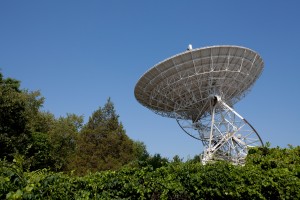
Peach Mountain Observatory. Image credit: James Rotz, Michigan Engineering Communications & Marketing
As a consolation prize to Michigan for their loss to the Now-Number-One-Ranked Hoosiers (in both polls!), today’s post features the University of Michigan 26-meter Radio Telescope at Peach Mountain Observatory. Built in 1958, this dish supplanted an 8.54-meter radio telescope that had been built just three years earlier. If you zoom in with Google Maps (here, I’ve already zoomed for you), you can see the smaller dish at the south of the observatory’s cleared property, with the large dish at the north.
The most interesting thing I discovered while trying to ferret out primary sources documenting the construction of the radio telescope was a stack of technical papers from the 1970s related to the Orbiting Geophysical Observatory (OGO) and Interplanetary Monitoring Platform (IMP-6). For instance:
- Low-Frequency Radio Astronomy Data from the University of Michigan Experiment Aboard IMP-6, 1971-74
- IMP-6 Solar Radio Burst Analysis Final Scientific Report
- Data User’s Notes: OGO-III Experiment Number 18 “Low-Frequency Radio Astronomy”
- Dynamic Spectra of 4-2 MHz Solar Burts: Results from Orbiting Geophysical Observatory III
- OGO-V Radio Burst Analysis
I love that a search for construction documents can lead to random readings on low frequency solar bursts and orbiting observatories.
Right click on the image above to download it or go to Michigan Engineering’s Peach Mountain Observatory set on flickr.